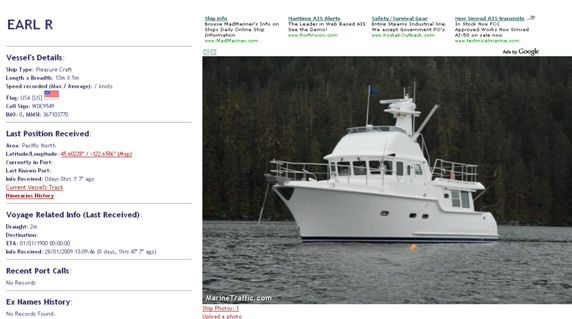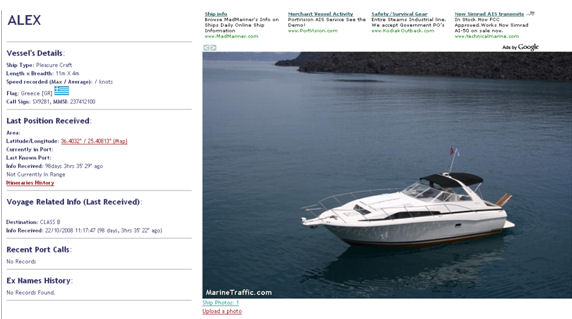Website for Global Tracking of AIS-Enabled
The University of the Aegean’s Dept.
of Product & Systems Design Engineering has created a website called MarineTraffic.com
which shows the way to boating of the future. Currently it is tracking several thousand
AIS transponders around the world including 225 recreational vessels most of which
are megayachts. But AIS units can be placed in any size boats and, in fact, in the
Med all recreational vessels over a certain size must be equipped with them. Since
2005 the International Maritime Organization has ruled that all vessels of 300 gross
tons or greater and all passenger vessels must carry AIS transponders. There are
services for commercial shipping, such as AISlive.com which tracks over 25,000 vessels,
but increasingly the benefit to recreational boaters of AIS are becoming apparent.
Our guess is that most cruising yachtsmen with boats 35’ or larger will want to
be equipped with AIS units in the future.

|
|
This map of the approaches to Pireas, Greece shows AIS-enabled commercial and recreational vessel traffic in “almost” real time. You can find this on MarineTraffic.com. |
The AIS both receives and transmits. The received signal
is displayed on your radar or chartplottter screen. The display shows the AIS target
as a long triangle symbol depicting vessel and the same symbol is used for a large
ship or small vessel. The triangle points in the direction the target vessel is
moving. This allows shipping to monitor traffic.
What are the Benefits of AIS to the recreational boater?
Avoiding other vessels on the water, and it’s especially in our best interests to
avoid the big guys whether in a shipping channel or not. Large ships have restricted
maneuverability and stopping range.
In fog, heavy rain, and at night it is often difficult or impossible to see exactly
what is going on. Even radar has its limitations. For example, how big is the vessel,
does it have a barge in tow, is one vessel behind another, are you seeing a vessel
or a marker. Depending on the power of one’s radar, small sailboats may not show
up at all.
Radar can not see around a bend in a river or past a point of land when the shoreline
is raised, but AIS on a chartplottter can identify that object if it has a transponder.
Large commercial shipping should have an alarm on their bridge AIS equipment to
warn when a target is too near or on a collision course. This only works of course
if someone is manning the bridge, yet another reason why recreational boats need
their own AIS.
The vessel description read out gives you other information about the vessel in
addition to its name. Often that is helpful. With the name you can hail the vessel
on your VHF and determine the best course to avoid trouble.
With tracking services such as MarineTRraffic.com or AISlive.com you can obviously
track your yacht’s whereabouts when you are not on it. Has your captain taken your
boat out for a midnight cruise with his new girlfriend? Is he running charters that
you don’t even know about? Has someone stolen your boat?
Both AISlive.com and MarineTraffic.com claim to cover 2000 ports, harbors and anchorages.
They also claim to update their data every three minutes to one hour. We are just
at the beginning of this brave new world of AIS and we suspect that many more applications
will be found for the system.

|
|
New York Harbor as it appears on MarineTraffic.com. Blue markers are passenger vessels (the Staten Island ferries in this case), red is for tankers, and other colors denote other types of vessels. |

|
|
MarineTraffic.com has thumbnail pictures of over 200 recreational vessels. |

|
|
This Nordhavn has a transponder and appears in the MarineTraffic.com database. |

|
|
You don’t have to own a megayacht to take advantage of AIS and be part of the tracking services. |